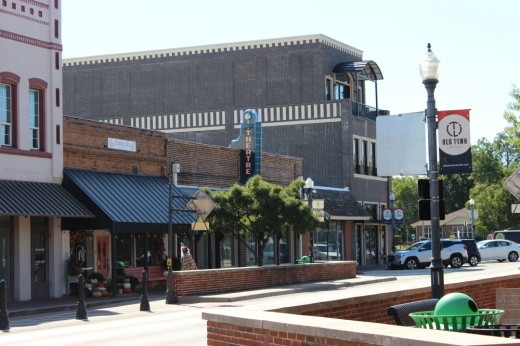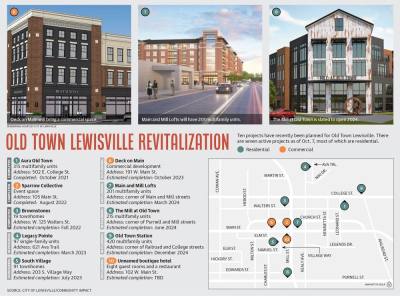While revitalization efforts in Old Town Lewisville have been ongoing for nearly 25 years, the area has seen a boom in recent activity with several projects slated to open over the next few years. Revitalization started with the decision to relocate City Hall to Old Town Lewisville in 1999, which provided the spark needed to bring the area back to life.
The area has since seen multiple new developments in recent years, including multifamily apartments and townhomes, such as Station at Old Town.
“The city spent a lot of money to bring this part of town back up,” Lewisville Mayor TJ Gilmore said. “It’s got a lot of development going on, a lot of opportunities for businesses down here and a cool place for residents to come. We’ve created a place and not just something people drive through.”
The goal of the revitalization is to turn Old Town Lewisville into a live, work and play destination, according to officials. They want the area to double as an entertainment district and a livable downtown.
There are seven active projects, Lewisville’s Economic Development Director Marichelle Samples said. Six of those projects are residential.
“We’re going to really end up a great destination place and just a great pocket of neighborhood because it will be a very walkable community,” said Lori Fickling, Lewisville Area Chamber of Commerce president.
Old Town history
Before modern development came to Old Town, the area was founded as a farming community in the 1840s.
The city’s first organized downtown, which ran through what is now Main Street, came along in the 1870s.
The opening of Vista Ridge Mall, which is now Music City Mall, in 1989 combined with growth on the city’s west side attracted commerce to that area, said James Kunke, the city’s community relations and tourism director. Activity and traffic in Old Town Lewisville decreased; new housing was not being built, and many buildings were vacant.
“I remember being down here in 2003, 2004 and seeing many of the buildings that are here were boarded up,” Gilmore said. “While it wasn’t urban blight, it was getting close.”
The town’s first City Hall building was built on the corner of Charles and Church streets in 1956 before it moved to the present-day Lewisville Municipal Annex, located at 1197 W. Main St., in 1989. The council had outgrown that space by 1999 and looked at Old Town as a new location site in an effort to revitalize the area, Kunke said.
Public investment continued when the city obtained a former church building for future use shortly after City Hall relocated to Old Town. That building eventually became Lewisville Grand Theater, which opened in 2011.
Other major public projects included Wayne Ferguson Plaza. The Lewisville Main and Mill Business Association also spearheaded a beautification project along the Main Street corridor.
While the city continues to invest in the area, redevelopment efforts have now largely been turned over to the private sector, Kunke said.
“The idea was that public investment often will spur private investment,” Kunke said. “If public investment is done well, if public money is invested in an area correctly, then it makes the area more viable.”
New developments
While developing the area, city officials looked to neighboring communities.
Kunke said the city looked to Plano, Carrollton and Grapevine for inspiration, the latter being the biggest influence for Old Town Lewisville’s revitalization because of its proximity and similar structure.
“There’s elements of each one that work for Lewisville,” Kunke said. “We weren’t going to duplicate anybody. People need to point to Lewisville and say, ‘That’s our model.’ That’s when we all know we’ve really gotten it done and gotten it done right is when other cities want to copy us.”
City Hall’s relocation was the domino that led to the construction of residential developments, Kunke said. Efforts slowed during the 2008 recession and again in the early days of the COVID-19 pandemic, but he said development in the area is now booming.
One of the major residential projects is the Main and Mill Lofts. The $35 million mixed-use project will have 201 luxury-style units and will be located at the corner of Main Street and Mill Street, according to project details. The two six-story buildings will include parking garages and retail on its respective first floors.
Another project is Old Town Station, located on College Street. It will be the largest multifamily development with 420 units. Another project, called Deck on Main, will be a 20,000-25,000 square-foot building with retail space anticipated for the first floor, office space on second floor and an event space on the third floor, according to project details.
Additionally, plans for a boutique hotel were approved in June. The proposed hotel will be located at 102 W. Main St. and will have eight guest rooms along with a restaurant that will be open to the public.
“A lot of the residential projects are because that helps spur the demand for that commercial activity, for the demand for that type of space,” Samples said. “That’ll bring a substantial amount of new residents to our city.”
Business benefits
Revitalization has brought new businesses to the area and helped existing businesses, according to local owners.
Kelly Blackall is a wedding photographer and board chair of The Main and Mill Association.
As a longtime resident and business owner in Old Town, Blackall said she has witnessed many changes, but The Main and Mill Association’s efforts, combined with loyal patronage, have helped businesses survive.
Blackall said change is hard, but revitalization has positively impacted her business and others in the area.
“It’s busier over here. A lot more people [are] walking up and down my street,” she said. “But as a business owner and someone who is in a business association, I love seeing all the fresh faces down here. That’s a blessing for business owners.”
Odin Leather Goods opened in the heart of Old Town in October 2021. The store’s owner, Odin Clack, said the area’s charm influenced his decision to move his retail store and manufacturing studio to 131 W. Main St.
“We’re not here to just take up space; we’re here to be a part of the area,” he said. “I would love for people to say some years from now, Old Town has benefited and value was added to Old Town because we were here.”
Keeping a vision
While the area has seen a number of changes through the years, revitalization efforts in Old Town have been met with challenges.
Changes have naturally been met with resistance from those who have an emotional attachment to the area, Kunke said. It is also more expensive and difficult to build in Old Town.
The city plans to preserve Old Town’s charm and character by ensuring new developments adhere to architectural and design standards. Kunke said the city is also committed to protecting historic buildings.
“If people choose to live in the Old Town district, there’s a reason, and we just need to make sure they don’t forget that reason,” he said.
Kunke said seeing the fruits of revitalization takes time; it is a process that can take decades.
“It’s a process that doesn’t really end. You reach milestones,” he said. “Old Town will never be totally finished. We’ll reach milestones. We can stop and take a breath, and look and say, ‘Wow we did that,’ and now what’s next?”






